Magnetic Properties Regulation of FeGa and FeGaNi Films with Oblique Magnetron Sputtering
Abstract
:1. Introduction
2. Experimental
3. Experimental Results and Discussion
4. Conclusions
Author Contributions
Funding
Institutional Review Board Statement
Informed Consent Statement
Data Availability Statement
Conflicts of Interest
References
- Alvarez-Quiceno, J.C.; Cabrera-Baez, M.; Ribeiro, R.A.; Avila, M.A.; Dalpian, G.M.; Osorio-Guillen, J.M. Emergence of competing magnetic interactions induced by Ge doping in the semiconductor FeGa3. Phys. Rev. B 2016, 94, 014432. [Google Scholar] [CrossRef]
- Fin, S.; Tomasello, R.; Bisero, D.; Marangolo, M.; Sacchi, M.; Popescu, H.; Finocchio, G.; Carpentieri, M.; Rettori, A.; Pini, M.G.; et al. In-plane rotation of magnetic stripe domains in Fe1−xGax thin films. Phys. Rev. B 2015, 92, 224411. [Google Scholar] [CrossRef]
- Clark, A.E.; Restorff, J.B.; Wun-Fogle, M.; Lograsso, T.A.; Schlagel, D.L. Magnetostrictive properties of body-centered cubic Fe-Ga and Fe-Ga-Al alloys. IEEE Trans. Magn. 2000, 36, 3238–3240. [Google Scholar] [CrossRef]
- Atulasimha, J.; Flatau, A.B. A review of magnetostrictive iron–gallium alloys. Smart Mater. Struct. 2011, 20, 043001. [Google Scholar] [CrossRef]
- Srisukhumbowornchai, N.; Guruswamy, S. Influence of ordering on the magnetostriction of Fe-27.5 at.% Ga alloys. J. Appl. Phys. 2022, 92, 5371–5379. [Google Scholar] [CrossRef]
- Zhao, P.; Zhao, Z.; Hunter, D.; Suchoski, R.; Gao, C.; Mathews, S.; Wuttig, M.; Takeuchi, I. Fabrication and characterization of all-thin-film magnetoelectric sensors. Appl. Phys. Lett. 2009, 94, 243507. [Google Scholar] [CrossRef]
- Yu, Y.; Zhan, Q.F.; Wei, J.W.; Wang, J.B.; Dai, G.H.; Zuo, Z.H.; Zhang, X.S.; Liu, Y.W.; Yang, H.L.; Zhang, Y.; et al. Static and high frequency magnetic properties of FeGa thin films deposited on convex flexible substrates. Appl. Phys. Lett. 2015, 106, 162405. [Google Scholar] [CrossRef]
- Song, N.; Lv, B.; Meng, J.; Gong, Z.; Zhang, X.; Zhan, Q. Tunable high-frequency properties of flexible FeGa films with rotatable stripe domain. J. Magn. Magn. Mater. 2021, 519, 167510. [Google Scholar] [CrossRef]
- Cao, D.; Cheng, X.; Pan, L.; Feng, H.; Zhao, C.; Zhu, Z.; Li, Q.; Xu, J.; Li, S.; Liu, Q.; et al. Tuning high frequency magnetic properties and damping of FeGa, FeGaN and FeGaB thin films. AIP Adv. 2017, 7, 115009. [Google Scholar] [CrossRef]
- Parkes, D.E.; Shelford, L.R.; Wadley, P.; Holý, V.; Wang, M.; Hindmarch, A.T.; Van Der Laan, G.; Campion, R.P.; Edmonds, K.W.; Cavill, S.A.; et al. Magnetostrictive thin films for microwave spintronics. Sci. Rep. 2013, 3, 2220. [Google Scholar] [CrossRef] [Green Version]
- Kuanr, B.K.; Camley, R.E.; Celinski, Z.; McClure, A.; Idzerda, Y. Single crystal Fe1−xGax thin films for monolithic microwave devices. J. Appl. Phys. 2014, 115, 17C112. [Google Scholar] [CrossRef]
- Dai, G.; Xing, X.; Shen, Y.; Deng, X. Stress-controlled dynamic susceptibility in FeGa stripes. J. Appl. Phys. 2018, 123, 243902. [Google Scholar] [CrossRef]
- Osaka, T.; Takai, M.; Hayashi, K.; Ohashi, K.; Saito, M.; Yamada, K. A soft magnetic CoNiFe film with high saturation magnetic flux density and low coercivity. Nature 1998, 392, 796–798. [Google Scholar] [CrossRef]
- Sheng, P.; Wang, B.; Li, R. Flexible magnetic thin films and devices. J. Semicond. 2018, 39, 011006. [Google Scholar] [CrossRef]
- Lou, J.; Insignares, R.E.; Cai, Z.; Ziemer, K.S.; Liu, M.; Sun, N.X. Soft magnetism, magnetostriction, and microwave properties of FeGaB thin films. Appl. Phys. Lett. 2007, 91, 182504. [Google Scholar] [CrossRef]
- Cao, D.; Wang, Z.; Pan, L.; Feng, H.; Cheng, X.; Zhu, Z.; Wang, J.; Liu, Q.; Han, G. Controllable magnetic and magnetostrictive properties of FeGa films electrodeposited on curvature substrates. Appl. Phys. A 2016, 122, 1–6. [Google Scholar] [CrossRef]
- Rementer, C.R.; Fitzell, K.; Xu, Q.; Nordeen, P.; Carman, G.P.; Wang, Y.E.; Chang, J.P. Tuning static and dynamic properties of FeGa/NiFe heterostructures. Appl. Phys. Lett. 2017, 110, 242403. [Google Scholar] [CrossRef]
- Endo, Y.; Sakai, T.; Miyazaki, T.; Shimada, Y. Effect of Film Thickness on the High Frequency Magnetic Properties of Polycrystalline Fe-Ga Films. IEEE Trans. Magn. 2017, 53, 1–5. [Google Scholar] [CrossRef]
- Pérez-Landazábal, J.I.; Recarte, V.; Sánchez-Alarcos, V.; Rodríguez-Velamazán, J.A.; Jiménez-Ruiz, M.; Link, P.; Cesari, E.; Chumlyakov, Y.I. Lattice dynamics and external magnetic-field effects in Ni-Fe-Ga alloys. Phys. Rev. B 2009, 80, 144301. [Google Scholar] [CrossRef]
- Zhang, Y.; Gan, T.; Wang, T.; Wang, F.; Shi, W. Giant magnetoimpedance effect in Fe75. 5Cu1Nb3Si13.5B7 ribbon/FeGa film composite. J. Magn. Magn. Mater. 2016, 417, 37–41. [Google Scholar] [CrossRef]
- Acosta, A.; Fitzell, K.; Schneider, J.D.; Dong, C.; Yao, Z.; Wang, Y.E.; Carman, G.P.; Sun, N.X.; Chang, J.P. Enhancing the soft magnetic properties of FeGa with a non-magnetic underlayer for microwave applications. Appl. Phys. Lett. 2020, 116, 222404. [Google Scholar] [CrossRef]
- Acosta, A.; Fitzell, K.; Schneider, J.D.; Dong, C.; Yao, Z.; Sheil, R.; Wang, Y.E.; Carman, G.P.; Sun, N.X.; Chang, J.P. Underlayer effect on the soft magnetic, high frequency, and magnetostrictive properties of FeGa thin films. J. Appl. Phys. 2020, 128, 013903. [Google Scholar] [CrossRef]
- Zhang, Z.; Sang, L.; Huang, J.; Wang, L.; Koizumi, S.; Liao, M. Tailoring the magnetic properties of galfenol film grown on single-crystal diamond. J. Alloys Compd. 2021, 858, 157683. [Google Scholar] [CrossRef]
- Jiang, J.S.; Bader, S.D. Magnetic reversal in thin film exchange-spring magnets. Scr. Mater. 2002, 47, 563–568. [Google Scholar] [CrossRef]
- Fullerton, E.E.; Jiang, J.S.; Bader, S.D. Hard/soft magnetic heterostructures: Model exchange-spring magnets. J. Magn. Magn. Mater. 1999, 200, 392–404. [Google Scholar] [CrossRef]
- He, Y.; Jiang, C.; Wu, W.; Wang, B.; Duan, H.; Wang, H.; Zhang, T.; Wang, J.; Liu, J.; Zhang, Z.; et al. Giant heterogeneous magnetostriction in Fe–Ga alloys: Effect of trace element doping. Acta Mater. 2016, 109, 177–186. [Google Scholar] [CrossRef]
- Zhang, X.; Zhan, Q.; Dai, G.; Liu, Y.; Zuo, Z.; Yang, H.; Chen, B.; Li, R.W. Effect of mechanical strain on magnetic properties of flexible exchange biased FeGa/IrMn heterostructures. Appl. Phys. Lett. 2013, 102, 022412. [Google Scholar] [CrossRef]
- Zhang, Y.; Huang, C.; Duan, Z.; Shi, W. Tuning static and dynamic magnetic properties of FeGa/Mn film. J. Magn. Magn. Mater. 2019, 477, 4–8. [Google Scholar] [CrossRef]
- Meng, C.; Wu, Y.; Jiang, C. Design of high ductility FeGa magnetostrictive alloys: Tb doping and directional solidification. Mater. Des. 2017, 130, 183–189. [Google Scholar] [CrossRef]
- Mudivarthi, C.; Datta, S.; Atulasimha, J.; Flatau, A.B. A bidirectionally coupled magnetoelastic model and its validation using a Galfenol unimorph sensor. Smart Mater. Struct. 2008, 17, 035005. [Google Scholar] [CrossRef]
- Ono, H.; Ishida, M.; Fujinaga, M.; Shishido, H.; Inaba, H. Texture, microstructure, and magnetic properties of Fe-Co alloy films formed by sputtering at an oblique angle of incidence. J. Appl. Phys. 1993, 74, 5124–5128. [Google Scholar] [CrossRef]
- Wang, Z.; Wang, F.; Hou, Z.; Xu, C.; Cao, D. Static and Dynamic Magnetic Properties of FeGa/FeNi (FeNi/FeGa) Bilayer Structures. Coatings 2020, 10, 383. [Google Scholar] [CrossRef]
- Budhathoki, S.; Sapkota, A.; Law, K.M.; Nepal, B.; Ranjit, S.; Shambhu, K.C.; Mewes, T.; Hauser, A.J. Low Gilbert damping and linewidth in magnetostrictive FeGa thin films. J. Magn. Magn. Mater. 2020, 496, 165906. [Google Scholar] [CrossRef]
- De Los Santos Valladares, L.; Ionescu, A.; Holmes, S.; Barnes, C.H.; Domínguez, A.B.; Quispe, O.A.; González, J.C.; Milana, S.; Barbone, M.; Ferrari, A.C.; et al. Characterization of Ni thin films following thermal oxidation in air. J. Vac. Sci. Technol. B 2014, 32, 051808. [Google Scholar] [CrossRef]
- Yan, W.; Li, H.; Liu, J.; Guo, J. EPMA and XRD study on nickel metal thin film for temperature sensor. Sens. Actuators A Phys. 2007, 136, 212–215. [Google Scholar] [CrossRef]
- Abo, G.S.; Hong, Y.K.; Park, J.; Lee, J.; Lee, W.; Choi, B.C. Definition of magnetic exchange length. IEEE Trans. Magn. 2013, 49, 4937–4939. [Google Scholar] [CrossRef]
- Janutka, A.; Gawroński, P. Domain walls in nanostripes of cubic-anisotropy ferromagnetic materials. IEEE Trans. Magn. 2014, 50, 1–4. [Google Scholar] [CrossRef]
- Neudert, A.; McCord, J.; Schäfer, R.; Schultz, L. Dynamic anisotropy in amorphous CoZrTa films. J. Appl. Phys. 2004, 95, 6595–6597. [Google Scholar] [CrossRef]
- Mühge, T.; Zeidler, T.; Wang, Q.; Morawe, C.; Metoki, N.; Zabel, H. Structural and magnetic studies of FexCo1−x (001) alloy films on MgO (001) substrates. J. Appl. Phys. 1995, 77, 1055–1060. [Google Scholar] [CrossRef]
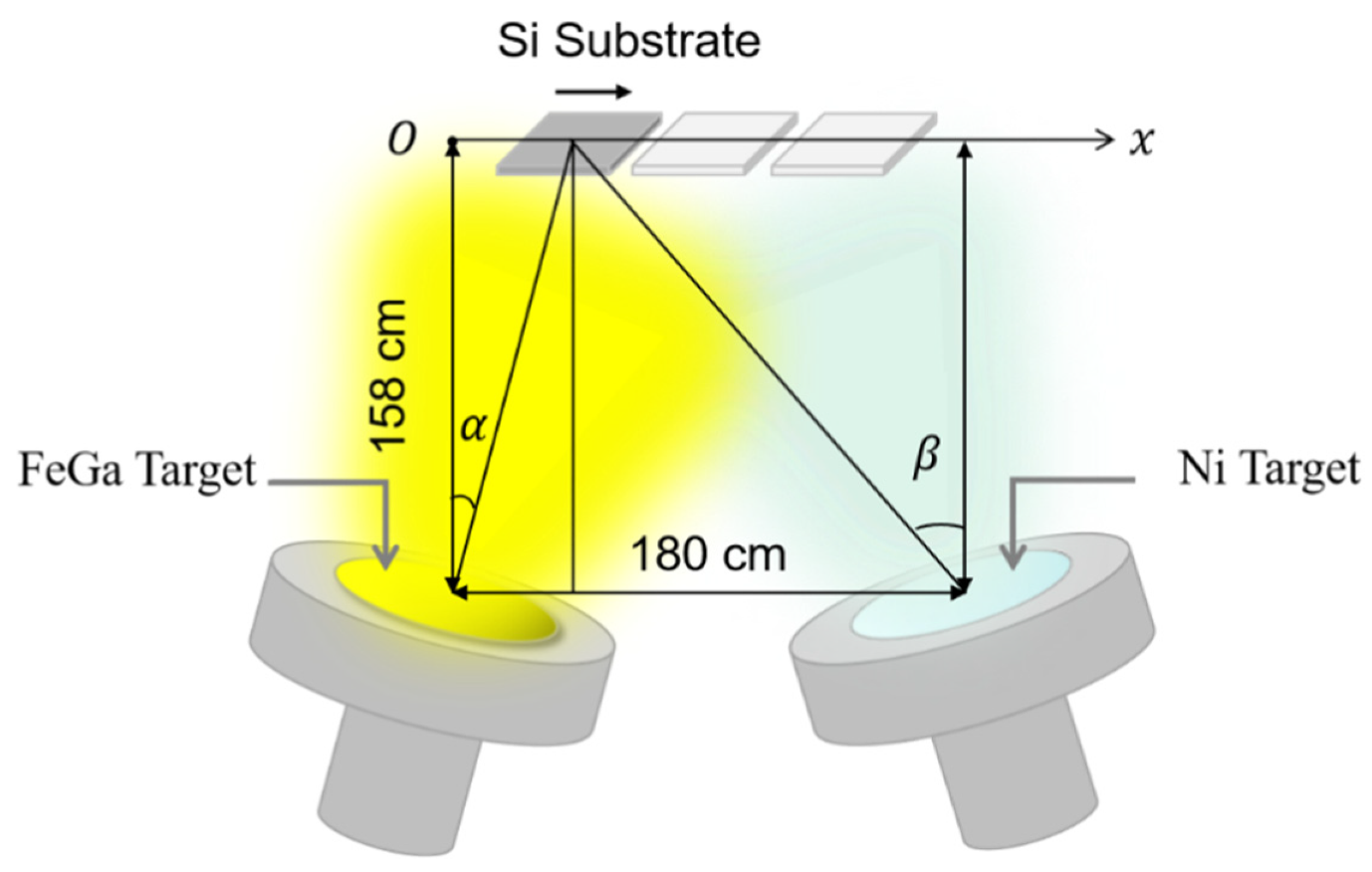
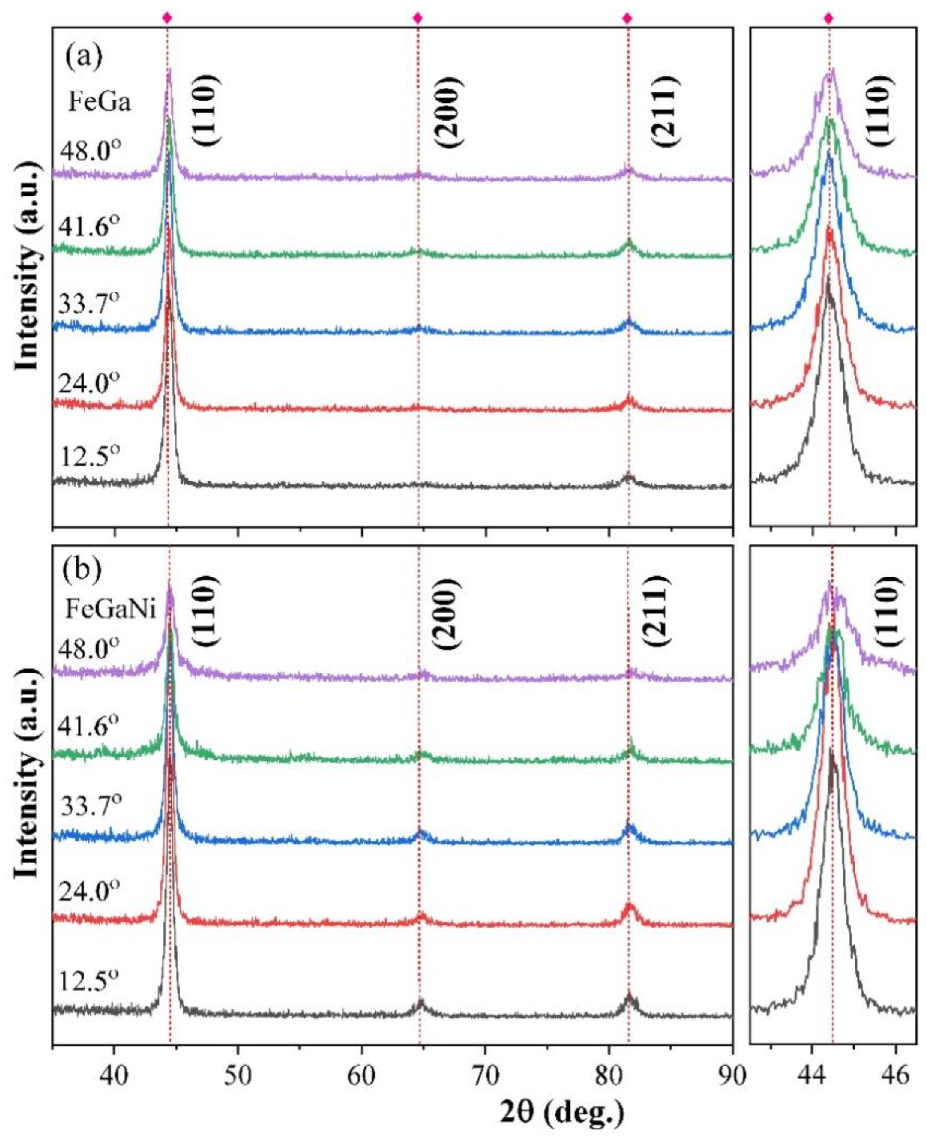
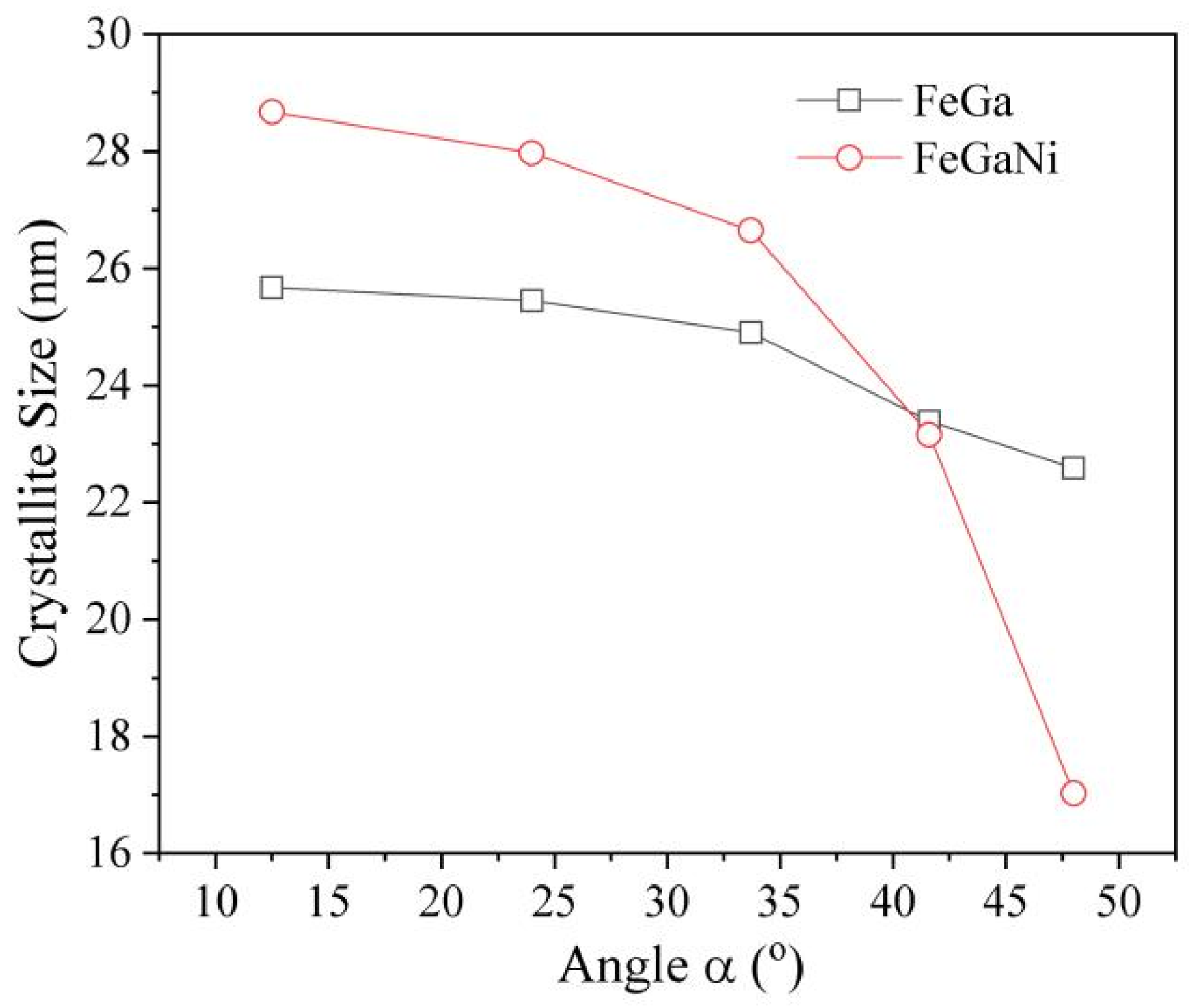
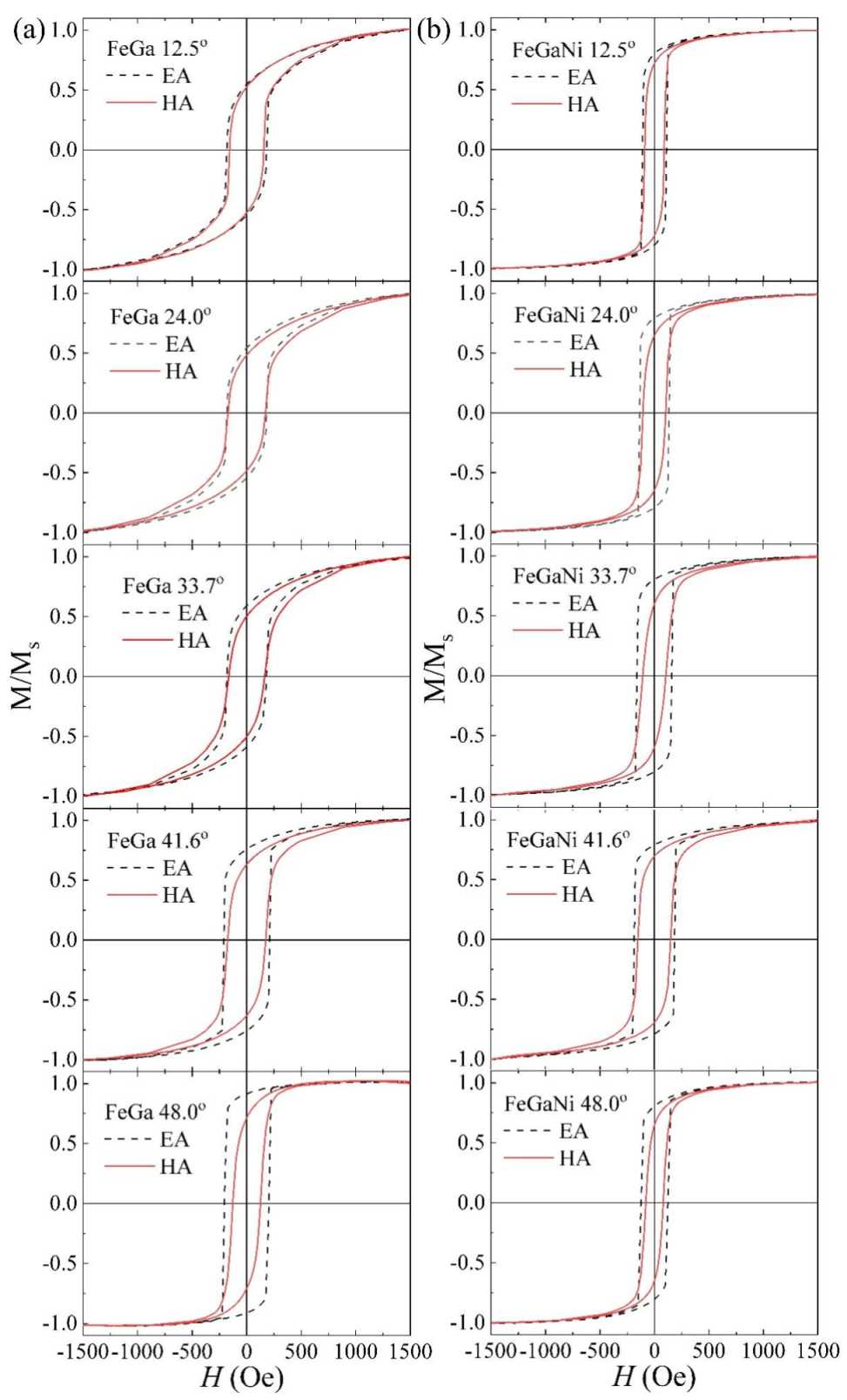
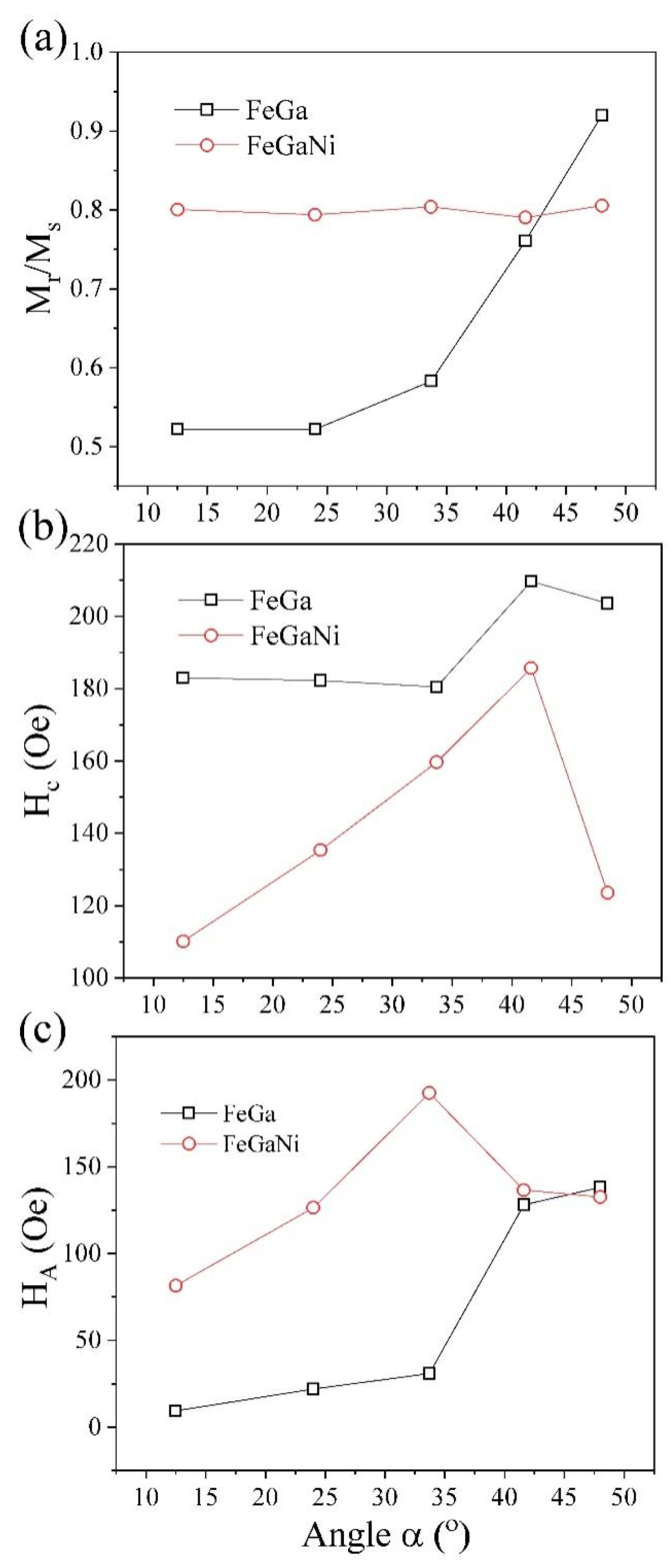
| x (cm) | 30 | 60 | 90 | 120 | 150 |
|---|---|---|---|---|---|
| α | 12.5° | 24° | 33.7° | 41.6° | 48° |
| β | 48° | 41.6° | 33.7° | 24° | 12.5° |
| A | 12.5° | 24° | 33.7° | 41.6° | 48° |
|---|---|---|---|---|---|
| Fe (%) | 84.5 | 84.25 | 83.56 | 83.06 | 82.75 |
| Ga (%) | 13.59 | 13.62 | 12.8 | 12.64 | 12.3 |
| Ni (%) | 1.66 | 2.31 | 3.64 | 4.31 | 5.95 |
| Fe:Ga | 6.24 | 6.19 | 6.53 | 6.57 | 6.65 |
Publisher’s Note: MDPI stays neutral with regard to jurisdictional claims in published maps and institutional affiliations. |
© 2022 by the authors. Licensee MDPI, Basel, Switzerland. This article is an open access article distributed under the terms and conditions of the Creative Commons Attribution (CC BY) license (https://creativecommons.org/licenses/by/4.0/).
Share and Cite
Wang, C.; Ke, S.; Wang, Z. Magnetic Properties Regulation of FeGa and FeGaNi Films with Oblique Magnetron Sputtering. Magnetochemistry 2022, 8, 111. https://doi.org/10.3390/magnetochemistry8100111
Wang C, Ke S, Wang Z. Magnetic Properties Regulation of FeGa and FeGaNi Films with Oblique Magnetron Sputtering. Magnetochemistry. 2022; 8(10):111. https://doi.org/10.3390/magnetochemistry8100111
Chicago/Turabian StyleWang, Chun, Sanmin Ke, and Zhen Wang. 2022. "Magnetic Properties Regulation of FeGa and FeGaNi Films with Oblique Magnetron Sputtering" Magnetochemistry 8, no. 10: 111. https://doi.org/10.3390/magnetochemistry8100111
APA StyleWang, C., Ke, S., & Wang, Z. (2022). Magnetic Properties Regulation of FeGa and FeGaNi Films with Oblique Magnetron Sputtering. Magnetochemistry, 8(10), 111. https://doi.org/10.3390/magnetochemistry8100111






